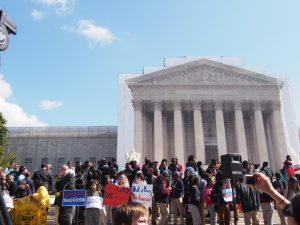By: Taryn Winston
Talk about kicking things off with a bang!
On Wednesday, October 10, 2012– just under two weeks after the start of the new term–the Supreme
Court of the United States heard oral arguments for Fisher v. University of Texas at Austin. The plaintiff, a white female named Abigail Fisher, filed suit against the defendant, the University of Texas at Austin, alleging that she was denied admission on the basis of race. While Fisher’s grades and test scores fell within the 25th and 75th percentiles of the University’s incoming class, she failed to earn an automatic acceptance under the institution’s Top Ten Percent plan. Under this plan, the University of Texas at Austin accepts students in the top ten percent of each Texas high school’s graduating class, regardless of their race. Fisher fell just shy of this mark and landed in the top twelve percent of her class. Thus, she was considered with the rest of the applicants whose extracurricular activities, family circumstances, and race were taken into account. She was then denied admission to the University of Texas at Austin and subsequently pursued legal action.
Fisher’s first attempts at challenging her rejection were unsuccessful; both the United States District and the Fifth Circuit Court of Appeals upheld the admissions policy on the basis that it complied with the standards created in Grutter v. Bollinger (2003), in which the Court held that race could play a role in the admissions policies of universities. Fisher and her attorneys subsequently petitioned to the Supreme Court, which ultimately granted certiorari.
While the Court is specifically ruling on the University of Texas at Austin’s admissions policy, it goes without question that its decision holds great importance for numerous colleges and universities throughout the country. Even more telling is the fact that the Court decided to hear the case in the first place, indicating that at least four of the nine justices were willing to revisit and perhaps overturn the Grutter standard. Whichever way the Court leans, it will undoubtedly be one of the most significant decisions of the John Roberts Court.
And speaking of the Chief Justice, many conservatives and opponents of affirmative action were initially fearful that Roberts would once again lean further to the left (as many say he did in the landmark healthcare ruling) and uphold the University’s policies. However, most of those fears were erased on that Wednesday morning during oral arguments. Roberts relentlessly fired questions at Gregory Garre, the attorney representing the University of Texas at Austin, and he was highly critical of the University’s admissions policy. Thus, it would be safe to assume that Roberts is a clear vote in favor of Abigail Fisher. Most likely joining Roberts are Justices Clarence Thomas, Antonin Scalia, and Samuel Alito. Thomas and Scalia, the two most conservative members of the Court, both dissented from the view of the Court in Grutter; they held that special considerations for racial minorities did violate the Fourteenth Amendment. Therefore, it seems logical that both men would rule similarly.
On the other side of the argument are Justices Ruth Bader Ginsburg, Stephen Breyer, and Sonia Sotomayor. Ginsburg and Sotomayor spent the bulk of their time questioning Bert Rein, the attorney representing Abigail Fisher; both Ginsburg and Breyer ruled with the majority in the Grutter decision. But with Justice Elena Kagan recusing herself from participation, the University’s best chance at a victory falls with the swing vote, Justice Anthony Kennedy. However, this is a difficult feat in and of itself, in part because Kennedy dissented from the majority in Grutter. But Kennedy has switched directions before, and if he does so again then the University’s admission policies would withstand another challenge in a four-to-four split.
But of course, this is more than just a challenge to the University of Texas at Austin. This is a direct challenge to affirmative action altogether. Though Texas’ Top Ten Percent plan is unique, several public colleges and universities across the country have enforced some type of affirmative action plan aimed at increasing minority enrollment. Take the University of Georgia, for example. In the past, UGA had enacted its own affirmative action admission policy. But in 2001, the Eleventh Circuit Court of Appeals struck it down, stating that it “unconstitutionally favored minority and male students.” Thus, the University of Georgia is now a race-neutral institution, choosing not to factor race in admissions decisions. But on the flip-side, Georgia Institute of Technology’s affirmative action policy is similar to that of the University of Texas at Austin. If the Court were to rule in favor of Abigail Fisher, Georgia Tech–as well as many other institutions– would undoubtedly be forced to restructure its policies accordingly.
While it could take months before the Supreme Court announces its decision, the strict division between the two sides of the argument is building. On one side, there are the proponents of affirmative action policies who argue that the only way to preserve diversity in universities is through affirmative action. On the other side, there are the opponents who argue that affirmative action is a form of “reverse discrimination”, unconstitutional under the Fourteenth Amendment.
Whichever way the Court rules, its decision is bound to have lasting consequences for every party involved. While the Grutter standard has withstood nearly ten years of controversy, Fisher v. University of Texas at Austin is unquestionably affirmative action’s biggest threat. Will the Court decide to uphold the admission policies and preserve a forty-year-old practice? Or will the Court take a different route and find the admission policies unconstitutional?
Quite a welcome back to a brand new term.

